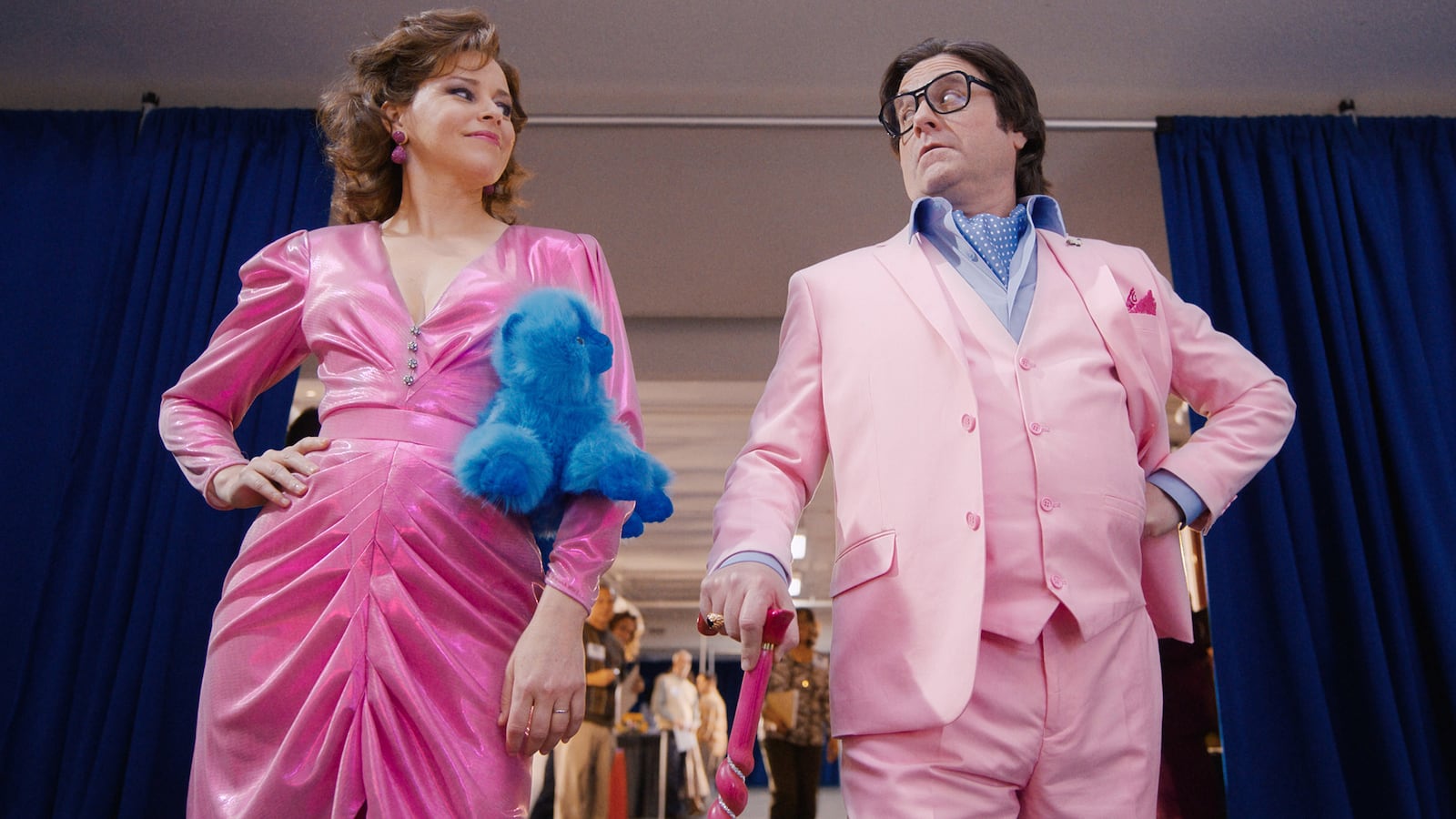Over and over throughout The Beanie Bubble—Apple TV+’s second cash-in on the seemingly undying corporate biopic trend this year, streaming July 28—characters repeat one word: “understuffed.” It’s an adjective used by toy company magnate Ty Warner, played here by Zach Galifianakis, to describe the signature product in his eponymous plush empire, Beanie Babies. Unfortunately, it’s also a fitting descriptor for The Beanie Bubble, a beyond-bland corporate biopic that’s as soft and trendy as its titular sensational stuffed animals.
For those of us lucky enough to be cognizant during the Beanie Babies boom of the 1990s, The Beanie Bubble will certainly conjure a decent amount of pleasant nostalgia. The movie does touch on some of your old favorites: Legs the Frog, Spooky the Ghost, and even a brief shot of the very mythic, yet not-at-all-expensive-to-buy-today Princess Diana bear. But like other recent Hollywood efforts to capitalize on that sweet, wistful feeling, nostalgia can’t take the place of a decent script and an engrossing story—no matter how cute the object at the center of it is.
The Beanie Bubble is based on Zac Bissonnette’s 2015 book The Beanie Bubble: Mass Delusion and the Dark Side of Cute, a title that itself seems a tad misleading, given how relatively tame Ty Warner’s misdeeds actually were, according to the film. Warner was a charismatic and driven entrepreneur, and like most enterprising men, he had little concern for the women around him. There’s Robbie (Elizabeth Banks), the woman who helped Ty Inc. get off the ground, and later became Warner’s girlfriend; Sheila (Sarah Snook), who married Ty after Robbie kicked him to the curb; and Maya (Geraldine Viswanathan), the college undergrad who took a minimum-wage job at Ty’s company, only to become the brains behind its eventual billion-dollar valuation.
The film introduces its core three women nimbly (if you can ignore the repetitive ticking time clock, our obnoxious guide to telling what decade the film is in). Snook and Viswanathan especially make for two captivating characters, with the former’s first scene as Sheila giving audiences a taste of Shiv Roy-lite. But Sheila’s sting and Maya’s pleasant acerbity quickly fade as they, along with Robbie, start to merely orbit around the glowing sun that is Ty.
And, to be fair, Galifianakis is damn good at playing a beguiling, flamboyant toy tycoon, which he does in The Beanie Bubble without a stitch of irony. This comes despite Banks’ voiceover at the top of the film, which firmly states, “This story’s not about him, it’s about us.” Yet the movie does little in the way to convince viewers of that, since it relies almost entirely on Ty to move the story forward.
Despite manufacturing the most massively desired toy of an entire decade, Ty Inc. started small—or, rather, too large. Ty’s original plush cats were much bigger than the Beanie Babies that kicked off the craze. Robbie, a fellow dreamer stuck in a dead-end auto shop job, might have helped Ty launch the company and make it profitable after they met in 1983, but it’s Sheila and her two children who suggest miniaturizing the animals so that a child could take their best plush friend with them everywhere. It takes a full decade for Ty to meet Sheila after his and Robbie’s cats become moderately successful. But from 1993 on, you couldn’t walk into a mom-and-pop shop (the only stores that Ty would sell to) without falling victim to a Beanie avalanche.
The film attributes a great deal of that success to Maya, who sparks Beanie Babies sales at a toy expo when she comes up with the ingenious concept of “Beanie retirement.” By indiscriminately deciding to deem certain Beanie Babies as limited-edition, Maya almost instantly increases the value and profits of the entire company. Viswanathan is as great at selling her character—the most expertly written woman of the trio—as Maya is at selling the Beanies. She has a distinct charm and an effervescence that even The Beanie Bubble’s complete lack of style can’t hamper.
But it’s hard to escape the feeling that directors Kristin Gore and Damian Kulash spend the film’s runtime trying to position Maya as the Eduardo Saverin to Ty’s Mark Zuckerberg. Except it’s a role that doesn’t quite fit. Ty, who would rather attribute her wit to himself than give her a promotion, takes advantage of Maya’s fantastic business acumen. Scenes in Ty Inc.’s nondescript, fluorescent-lit office recall more compellingly staged and shot moments from The Social Network, without any of that film’s breathless stakes. Gore and Kulash treat the subject of Beanie Babies far too softly. That might fit for the plush product being discussed, but it doesn’t make for an intriguing biopic about the insidious nature of capitalism, which can apparently overtake even the most cuddly of toymakers.
What’s more frustrating is the film’s misuse of its women characters. Robbie, Sheila, and even Maya are sprinkled throughout the movie’s non-linear timeline so as not to be forgotten—or perhaps, so The Beanie Bubble can convince audiences of its underwritten attempts to make them the stars of Ty’s show. But their stories are wrapped up in stereotypical fashion, hoping that a few epigraphs will service their characters more than the film ends up doing. Had the movie solely been about Maya, whose arc is unquestionably the most engaging of the three, The Beanie Bubble could’ve separated itself from the onslaught of paint-by-numbers corporate biopic dreck inundating Hollywood as of late.
That’s not to say The Beanie Bubble is completely unwatchable; the film makes for an easy stroll down memory lane on a hot summer afternoon. But it’s also a firm reminder that the culture’s Beanie obsession was the most interesting part of this relatively brief craze, not its creator’s misdeeds. Max’s 2021 documentary Beanie Mania covered that same ground, as well as a good amount of Ty’s business woes, in a slick 80-minute package. The Beanie Bubble will make a nice footnote for any holdovers who haven’t been able to unstick themselves from that time. For the rest of us, it’s merely palatable, digital sludge disguised as navel-gazing nostalgia.






